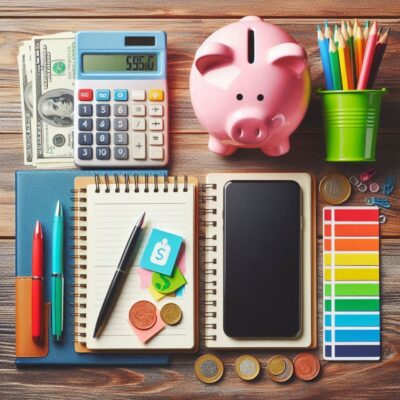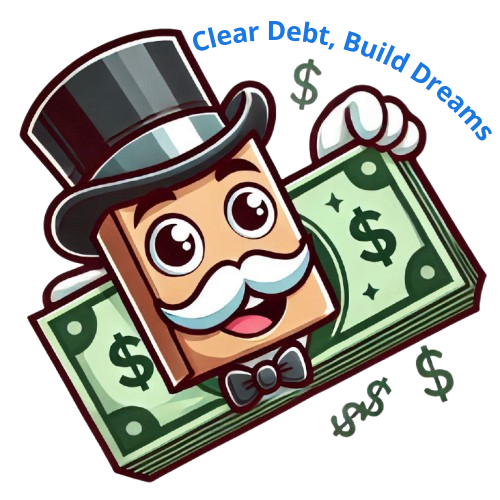Figuring out where you stand with your credit card debt is the first step towards tackling it. Seriously, you need a clear picture. Start by listing all your credit cards with their outstanding balances and interest rates. Don’t skip this — it’s crucial for forming your payoff plan.
Interest rates dictate how fast your debt grows. Cards with higher rates will eat more of your money if you’re just making minimum payments. Make sure you know the rates and how they impact your total balance. It might surprise you how much you’re dishing out just in interest!
A detailed budget helps find extra cash to throw at your debt. Track every dollar you spend for a month. This isn’t about feeling guilty; it’s about knowing where your money goes. You need this info to stash away a bit more for those payments.
Identifying unnecessary expenses can be a total game-changer. Look at your subscriptions, dining out, and impulse buys. Cutting back even a little frees up money to pay down your credit cards faster. Little changes add up quicker than you think.
Here’s a little transparency: Our website contains affiliate links. This means if you click and make a purchase, we may receive a small commission. Don’t worry, there’s no extra cost to you. It’s a simple way you can support our mission to bring you quality content.”
Contents
- 0.1 Tools and Resources to Help You
- 0.2 Effective Strategies to Pay Off Credit Card Debt Quickly
- 0.3 Real-Life Success Stories – Inspiring Tales of Rapid Credit Card Debt Payoff
- 0.4 How to Pay Off $10,000 Quickly
- 1 Debt Repayment Calculator
Tools and Resources to Help You
Several mobile apps can help you budget and track expenses, making it easier to stick to your debt repayment plan. Apps like Mint, YNAB (You Need A Budget), and PocketGuard can automate tracking and offer insights into your spending habits, which is super handy.
Non-profit credit counseling services offer professional advice for free or at a low cost. They can help you develop a personalized plan to manage your debt and might even negotiate with creditors on your behalf. Organizations like the National Foundation for Credit Counseling (NFCC) can be a valuable resource.

Online financial calculators are great for visualizing your debt payoff journey. They let you play around with different payment amounts and strategies to see how soon you can pay off your debt. Websites like Bankrate and NerdWallet offer these tools for free.
Diving into books and online courses on personal finance can also offer valuable insights and strategies. Titles like “The Total Money Makeover” by Dave Ramsey or taking a finance course on platforms like Coursera or Udemy can arm you with the knowledge to manage your finances better.
Effective Strategies to Pay Off Credit Card Debt Quickly
The Debt Snowball Method can be a real motivator. Focus on paying off your smallest debt first while making minimum payments on the others. Once that’s gone, roll that payment into the next smallest debt. It’s all about momentum and seeing quick wins.
The Debt Avalanche Method, on the other hand, targets high-interest debts first. You tackle the debt with the highest interest rate while making minimum payments on the rest. This can save you money long-term since you’re cutting down on interest charges.
Balance Transfer Cards offer another solid option. By transferring your debt to a card with a lower interest rate or even an introductory 0% APR, you can save on interest. Just watch out for transfer fees and make sure to pay off the balance before the introductory period ends.
Personal Loans can help you consolidate multiple credit card debts into one fixed-rate loan. You might end up with a lower interest rate and a single monthly payment, making it easier to manage. Shop around to find the best rate that fits your situation.
Don’t underestimate the impact of bonuses and windfalls. Whether it’s a tax refund, bonus from work, or even selling some stuff you don’t need anymore, funnel that money straight into your debt. These chunks can make a significant dent in what you owe.
Real-Life Success Stories – Inspiring Tales of Rapid Credit Card Debt Payoff
Include a dedicated section in your article showcasing three real-life stories of individuals who quickly eliminated their credit card debt. Structure the stories as engaging mini-case studies, highlighting their struggles, strategies, and successes. Here’s how you can present them:
Story 1: Amber’s $10,000 Debt Snowball Triumph
- Background: Amber, a 28-year-old marketing professional, had accumulated $10,000 across three credit cards due to a mix of online shopping and unexpected medical bills.
- Strategy:
- Amber used the Debt Snowball Method, starting with her smallest balance of $1,500.
- She cut unnecessary expenses like subscriptions and dining out, reallocating $600 per month toward debt payments.
- To stay motivated, Amber tracked her progress using a visual debt payoff chart.
- Results:
- Paid off her smallest debt in 3 months.
- Cleared all $10,000 in just 18 months.
- Total interest saved: $3,200.
- Key Takeaway: Breaking debt into smaller, achievable goals kept Amber motivated and disciplined.
Story 2: Mike’s Avalanche Attack on High-Interest Credit Cards
- Background: Mike, a 35-year-old engineer, faced $15,000 in credit card debt, with interest rates ranging from 18% to 25%. His biggest challenge was the growing interest charges.
- Strategy:
- Mike adopted the Debt Avalanche Method, tackling his highest-interest credit card (25% APR) first.
- He took on a freelance side hustle as a graphic designer, earning an extra $1,000/month, all of which went toward his debt.
- He negotiated lower interest rates on two cards by calling his creditors and citing his payment history.
- Results:
- Paid off $15,000 in 16 months.
- Interest saved: Over $4,000.
- Avoided taking on new debt by sticking to a strict budget.
- Key Takeaway: Targeting high-interest debt first and earning extra income accelerated Mike’s debt freedom.
Story 3: Maria and John’s Team Approach to Debt Reduction
- Background: Maria and John, a married couple in their early 40s, had $25,000 in combined credit card debt after home renovations and family expenses.
- Strategy:
- They created a joint budget, cutting $1,200/month from discretionary spending.
- Used a balance transfer credit card with 0% APR for 18 months to consolidate their highest-interest debts.
- Dedicated Maria’s bonuses and John’s overtime pay entirely to debt payments.
- Results:
- Paid off $25,000 in 20 months.
- Avoided nearly $5,000 in interest by using the 0% APR balance transfer.
- Strengthened their financial partnership and learned to prioritize saving.
- Key Takeaway: Working together as a team and taking advantage of balance transfer offers helped Maria and John stay focused and efficient.
How to Pay Off $10,000 Quickly
Combining strategies can supercharge your debt payoff. Use a mix of the Debt Snowball and Debt Avalanche methods to keep motivated and minimize interest. Applying windfalls and bonuses right away can give you a solid jumpstart.
Take a hard look at your spending habits. Immediate changes like reducing dining out, canceling subscriptions, or switching to a cheaper phone plan can free up cash quickly. This extra money should go straight into your debt payments.
Boosting your income can make a big difference. Consider picking up a side gig, freelance work, or selling items you no longer need. Every extra dollar counts when you’re gunning to pay off that $10,000.
Negotiating lower interest rates with your card issuers can also help. A phone call might lower your rates, saving you money long-term. Just explain your intention to pay down debt and ask for a break on your rate.
Financial discipline is the key to staying on track. It’s not just about paying off the debt but keeping yourself from falling back into the same hole. Consistently review your budget, track your progress, and stick to your plan to keep moving forward.

credit card spending
Debt Repayment Calculator
Instructions for Using the Debt Repayment Calculator
The Debt Repayment Calculator is a user-friendly tool designed to help you identify the quickest way to pay off your credit card debt. Follow the steps below to make the most out of it:
Step 1: Add Your Credit Cards
- Click the “Add Another Card” button to input the details of each credit card.
- For each card, fill in:
- Balance: Enter the current balance for that card.
- Interest Rate: Provide the annual interest rate (APR) for the card (e.g., 18%).
- Repeat this process for all your credit cards.
Step 2: Input Your Monthly Budget
- In the “Monthly Budget” field, enter the total amount you can allocate to debt payments each month.
- This budget should include any extra money you can put toward paying off your debt faster.
Step 3: Calculate Your Repayment Plan
- Once all the credit card details and your monthly budget are entered, click the “Calculate” button.
- The calculator will compute two repayment strategies:
- Debt Snowball Method: Focuses on paying off the smallest balances first while making minimum payments on the larger ones.
- Debt Avalanche Method: Prioritizes paying off the highest-interest debts first, minimizing total interest paid.
Step 4: Review Your Results
- The results are displayed in two tables:
- Debt Snowball Results: Shows a month-by-month breakdown of:
- Remaining debt balance.
- Total interest paid.
- Debt Avalanche Results: Displays the same information but for the avalanche repayment strategy.
- Debt Snowball Results: Shows a month-by-month breakdown of:
- Compare the results to decide which method works best for your situation.
Step 5: Take Action
- Use the repayment timeline provided in the results to set monthly goals.
- Stick to your budget and monitor your progress to achieve debt freedom faster.
Tips for Maximizing the Calculator
- Test different budgets: Adjust your monthly payment to see how increasing it can shorten your timeline.
- Add new cards if necessary: Recalculate if you take on additional debt or have new balances.
- Revisit regularly: Update the calculator as your balances decrease or your financial situation changes.
Long-Term Financial Health and Credit Card Management
Building an emergency fund is vital once your debt is under control. Start with a small goal, like $1,000, and gradually build it up to cover 3-6 months of expenses. This fund helps you avoid falling back into debt when unexpected costs pop up.
Maintaining a good credit score is crucial for your financial health. Timely payments and keeping your credit utilization low are key factors. Regularly check your credit report for errors and address any issues promptly.
Avoiding future debt is easier when you stick to habits you’ve built. Keep tracking your expenses, stick to your budget, and be mindful of your spending impulses. Learning to live within your means is a lifelong skill that pays off.
Consistent review and adjustment of your financial plan keep you on track. Life changes and financial goals evolve, so make it a habit to revisit your budget and debt repayment strategies regularly. Adjust as needed to stay aligned with your objectives.

